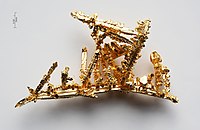
Photo from wikipedia
Two new tetralactam macrocycles with 2,3-dibutoxynaphthalene groups as sidewalls have been synthesized and characterized. The macrocycle containing isophthalamide bridges can bind square-planar chloride coordination complexes of gold(III), platinum(II), and palladium(II)… Click to show full abstract
Two new tetralactam macrocycles with 2,3-dibutoxynaphthalene groups as sidewalls have been synthesized and characterized. The macrocycle containing isophthalamide bridges can bind square-planar chloride coordination complexes of gold(III), platinum(II), and palladium(II) in CDCl3, while the macrocycle with 2,6-pyridine dicarboxamide bridging units cannot. This may be due to the shrunken cavity caused by intramolecular hydrogen bonds in the latter tetralactam macrocycle. The binding of the isophthalamide-based macrocycle is mainly driven by hydrogen bonds and electrostatic interactions. This naphthalene-based macrocycle has similar binding affinities to all the three abovementioned precious metal chloride complexes. This is in contrast to the fact that the tetralactam macrocycle with anthracene as the sidewalls only show good binding affinities to AuCl4−. The superior binding to all three complexes may be due to the conformational diversity of the naphthalene-based macrocycle, which make it conformationally adaptive to maximize the binding affinities. In addition, the macrocycle shows fluorescent quenching when adding the chloride metal complexes in its solution and may be used as a fluorescent sensor for the detection of these coordination complexes.
Journal Title: Beilstein Journal of Organic Chemistry
Year Published: 2019
Link to full text (if available)
Share on Social Media: Sign Up to like & get
recommendations!